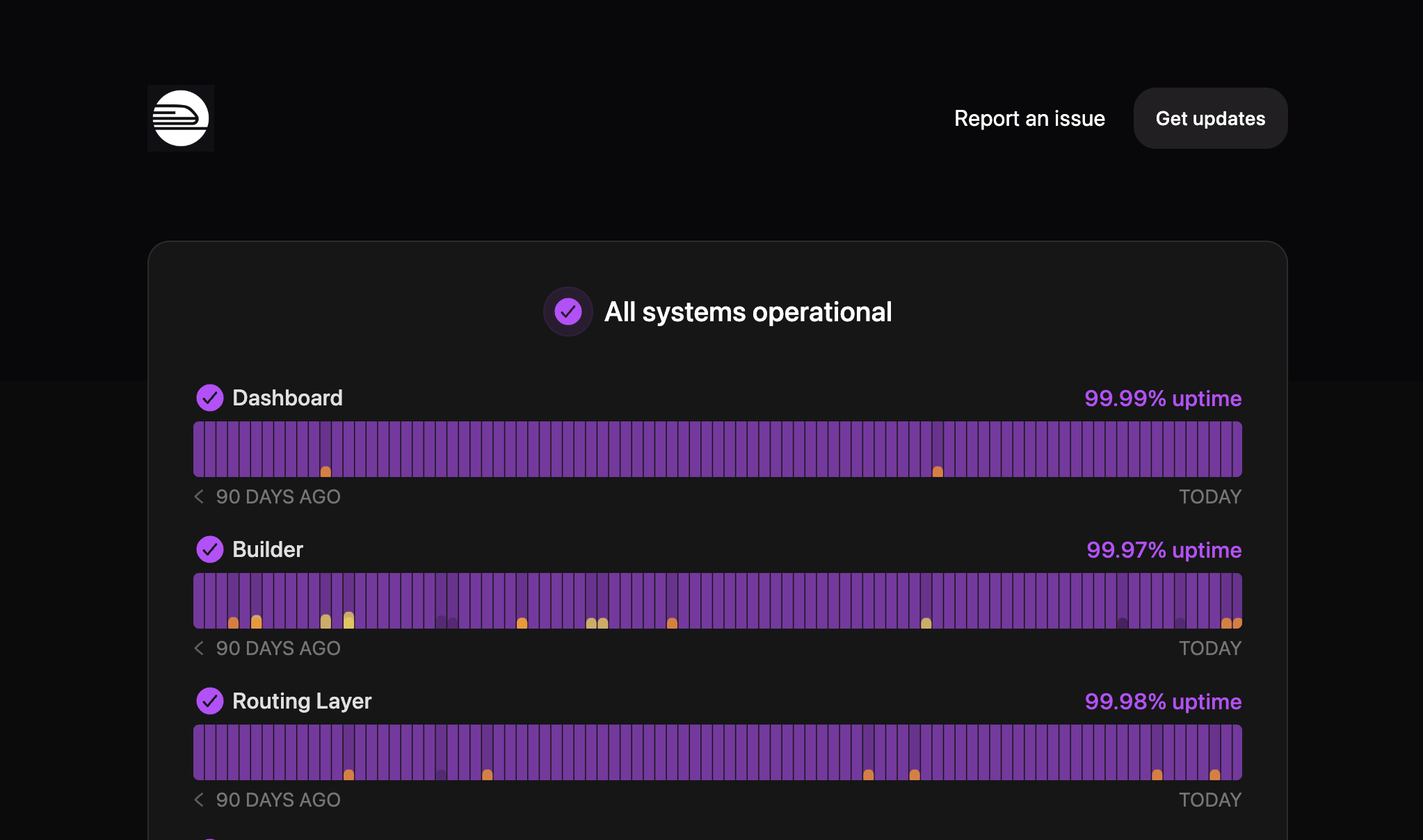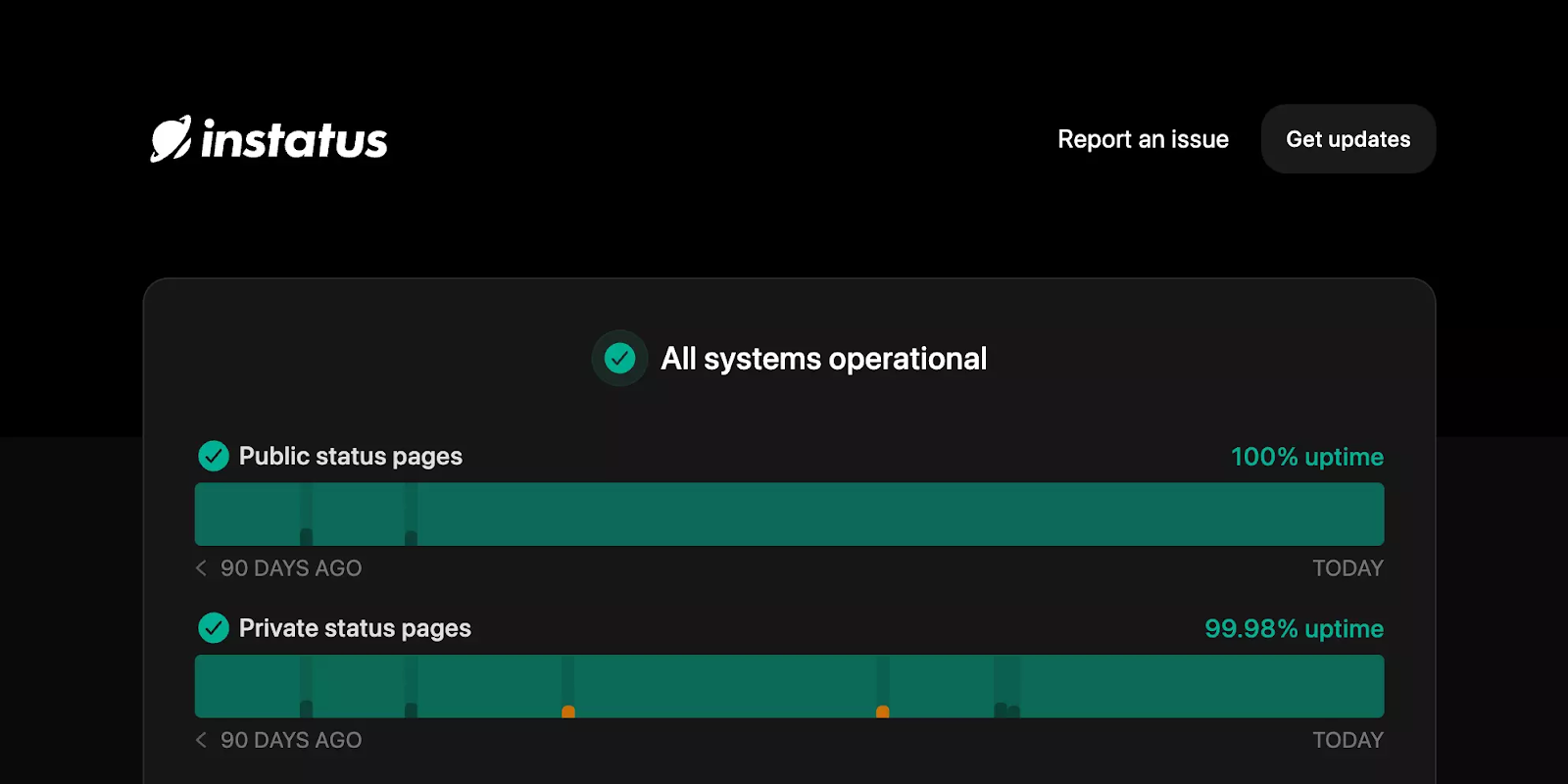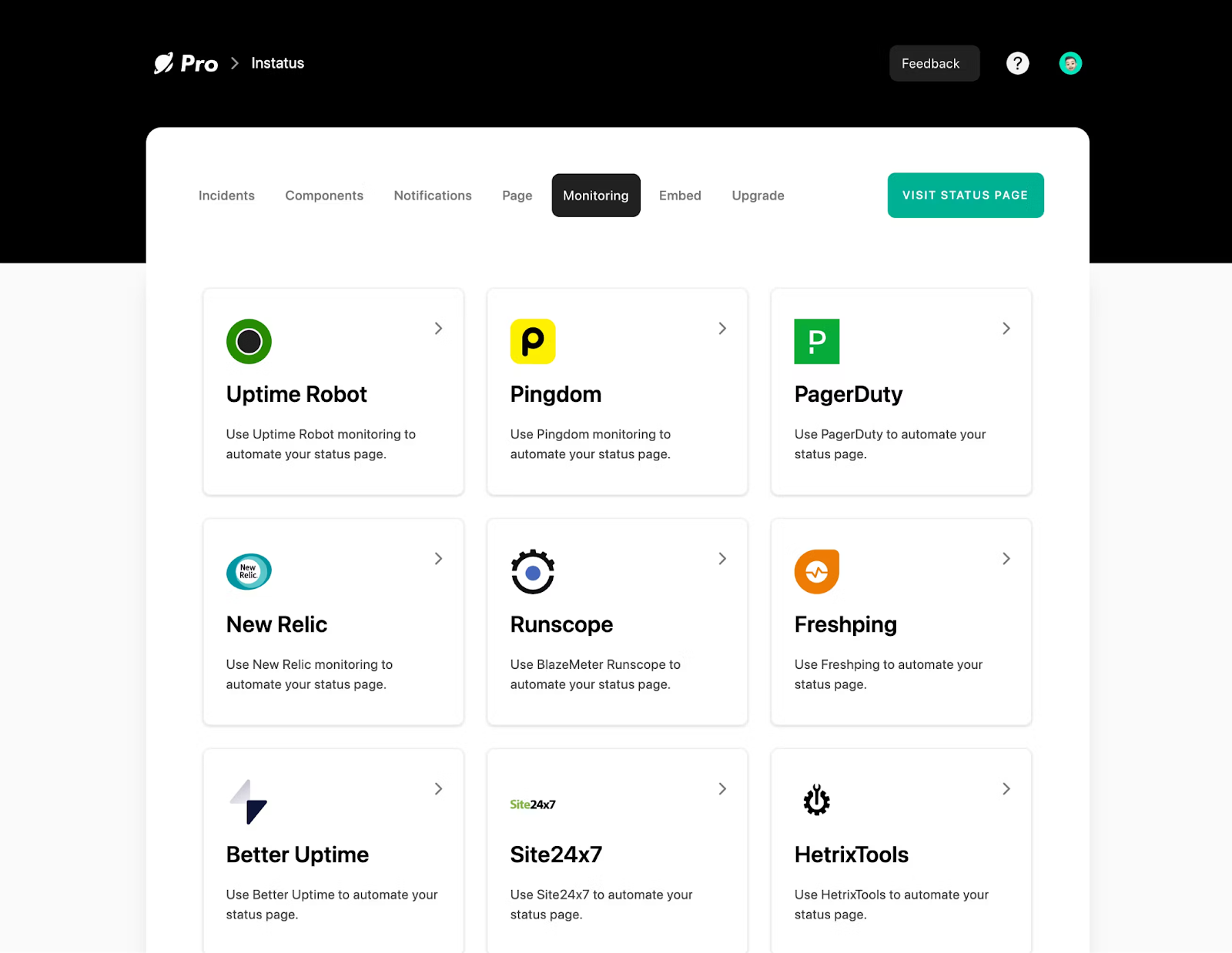We Explored The Best Splunk Alternatives You Should Consider

Quick summary
We explore top alternatives to Splunk, highlighting flexible, scalable, and cost-effective tools for digital system monitoring and incident management. Our insights are backed by real-world use cases, such as Continental Group IT’s success with Splunk. Choosing the right tool depends on your organization’s unique needs. For continued guidance on monitoring trends and emerging solutions, explore more expert insights on the Instatus blog.
Need Help Finding a Splunk Alternative?
As organizations depend more on complex digital setups, it's crucial to have strong solutions that monitor, analyze, and secure your systems. Splunk is a popular platform in this arena, offering a comprehensive platform for log management, security information and event management (SIEM), and data analytics.
However, recognizing the different organizational needs and preferences, it is essential to explore alternatives that might better suit specific requirements.
In this Instatus article, we will explore a range of Splunk alternatives, examining their features, capabilities, and suitability for various use cases. Let’s dive in!
Why Listen To Us?
At Instatus we have empowered numerous clients, including prominent ones like Railway and Deno, to enhance their system monitoring and incident management. We offer a quick, cost-effective, and user-friendly alternative to traditional monitoring services.
Our platform is praised for its efficiency and ease of use, as evident in the satisfaction of our diverse client base, ranging from small startups to large enterprises.
What is Splunk?
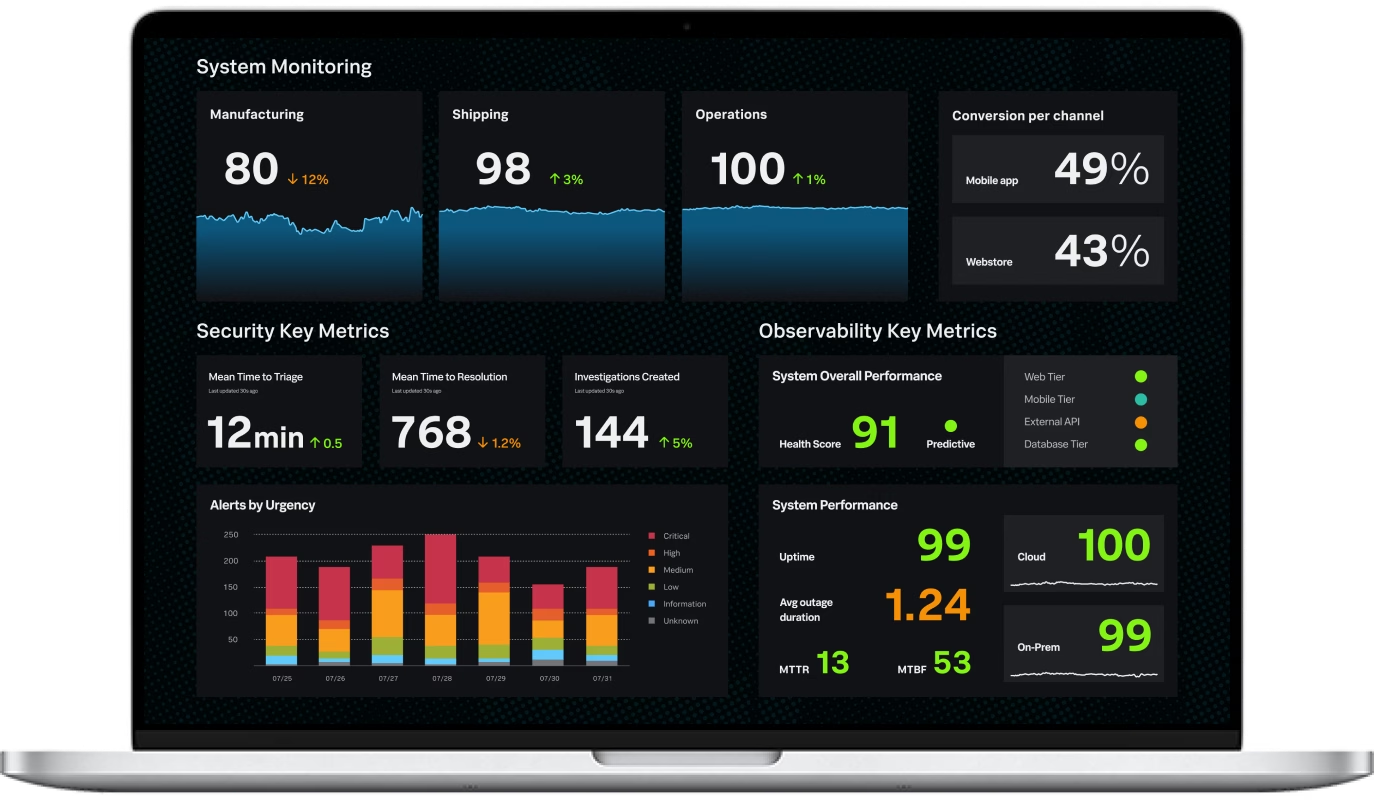
Splunk is a solution designed to keep your digital systems secure and operational. It serves as a key tool for enterprise resilience, trusted by leading organizations globally. With Splunk, you can potentially defend against threat actors, minimize downtime, and resolve issues swiftly. Its impact-absorbing capabilities enable the rapid restoration of critical services, ensuring minimal disruptions during outages or breaches.
Supported by a vast network of over 2,200 partners and a community of 13,000 active members, Splunk offers not just a product but an ecosystem of support. With 1,800 Splunk experts available, you can count on tailored assistance to architect, deploy, and scale according to your needs.
Here are some of the Splunk’s features:
- Advanced Threat Detection: Expose advanced threats and internal malice that escape regular detection methods.
- Extend Visibility to the Cloud: Transition to the cloud with assurance with Splunk's extensive analytics-based monitoring and problem-solving for hybrid IT infrastructure on a large scale.
- Isolate Problems in Cloud-Native Environments: Simplify problem-solving in cloud-native settings for quicker issue resolution. Predictive Analytics and Machine Learning: Leverage the tool’s built-in machine learning features to predict potential issues, prevent them from aggravating, and optimize performance across your IT infrastructure. Real-Time Monitoring and Alerting: Monitor your entire IT environment in real time with Splunk’s robust alerting system. Get instant notifications for anomalies, performance bottlenecks, and security threats, paving the way for immediate action to mitigate risks and maintain optimal system performance.
Splunk Case Study: Continental

Continental Group IT faced a challenge in accessing and sharing information swiftly across teams. The manual process of collecting and analyzing data was impeding the pace of innovation within the organization.
Splunk offered clear insights through its dashboards, giving the Active Directory staff worldwide a 24/7 monitoring capability. With a focus on foundational information such as space and time sync issues, CPU usage, and network traffic, Splunk not only streamlined data analysis but also allowed for proactive detection and correction of machine issues.
The use of Splunk Enterprise dashboards enabled continuous monitoring, ensuring heightened security and more resilient systems. Overall, Splunk played a pivotal role in catapulting Continental Group IT into a more efficient and innovation-friendly operational mode.
Instatus provides a fresh approach to status page management, offering a simple and cost-effective solution. Create an impressive status page effortlessly in just 10 seconds, without the high costs associated with other platforms like Splunk.
With Instatus, keeping your customers informed during downtime becomes a breeze. Say goodbye to excessive support tickets, and enhance customer trust by showcasing both current and historical uptime.
Why Look For Splunk Alternatives?
While Splunk stands out as a popular and powerful choice for many, it's essential to consider other options that may align more closely with your organization's unique objectives and constraints. Here are some of the reasons why you should consider other alternatives:
- Cost: Splunk is a commercial product generally more expensive than open-source alternatives. Users on a tight budget may prefer open-source options, which can offer similar functionalities at a lower or no cost.
- Flexibility and Customization: Some alternatives are often more flexible and customizable than Splunk. They can be modified and extended to meet specific needs, and users have access to the source code, offering a significant advantage for businesses with unique requirements.
- Integration with Other Tools: Some businesses prefer using open-source tools that can be easily integrated with other open-source technologies, rather than being tied to a proprietary platform like Splunk.
- Handling of Large Data Volumes and Interface: Some customers find Splunk not the best for managing large quantities of data and criticize its licensing model and outdated interface. Users seeking more modern, user-friendly interfaces or better scalability might look for alternatives.
- Specific Needs and Workflow Compatibility: Users sometimes seek more niche-focused solutions with different pricing structures or interfaces that better suit their team's workflow. In such cases, finding a Splunk competitor becomes a quest for a solution that caters more precisely to their unique needs and circumstances.
Criteria To Look For When Choosing A Splunk Alternative
Here are some criteria to consider when choosing an alternative to Splunk:
Real-time Monitoring
Ensure the chosen platform excels in real-time monitoring, enabling immediate and continuous tracking of your digital systems' activities. This feature is critical for promptly identifying and responding to potential security threats, system anomalies, or performance issues.
With capabilities ranging from website and API monitoring to keyword, SSL, TCP, ping, and DNS checks, Instatus provides a holistic approach to system health. We conduct 30-second checks from multiple locations, enabling immediate detection of any disruptions or performance issues.
Integration
Choose a solution that excels in seamless integration, allowing effortless collaboration with existing tools and technologies within your digital ecosystem. A robust integration capability ensures that your chosen platform can smoothly connect and interact with various software applications, databases, and infrastructure components.
Instatus takes monitoring to a new level by offering seamless integrations with popular monitoring tools such as Site24x7, Pingdom, and Datadog.
Customization Options
Opt for a solution that offers flexibility and customization to tailor security measures according to your specific organizational needs.
Scalability
Prioritize a platform that demonstrates exceptional scalability, ensuring it can effectively adapt and expand alongside the evolving demands of your digital systems. Scalability goes beyond just accommodating growth, it involves the platform's capacity to handle increased data, users, and transactions without compromising performance or security.
Vendor Support and Community
When considering a platform for securing and maintaining your digital systems, it is crucial to thoroughly evaluate the support infrastructure provided by the vendor and the vibrancy of the associated community.
The level of responsiveness and expertise from the vendor's support team directly influences your ability to address issues swiftly and maintain the resilience of your systems.
Data Ingestion and Indexing Efficiency
Your Splunk alternative should efficiently manage enormous volumes of data ingestion and indexing without major performance degradation. If not, you’ll risk the speed and accuracy of your analytics.
Cost and Licensing Flexibility
Make sure you study the pricing model and licensing options of your chosen tool to ensure it aligns with your budget and usage needs, especially if your data volumes and analytics requirements will grow over time.
Best Splunk Alternatives
Here’s our list of the best Splunk alternatives you can consider:
- Datadog
- New Relic
- SolarWinds
- Dynatrace
- Nagios
- Graylog
- Sumo Logic
- ELK Stack
- Fluentd
- Humio
1. Datadog
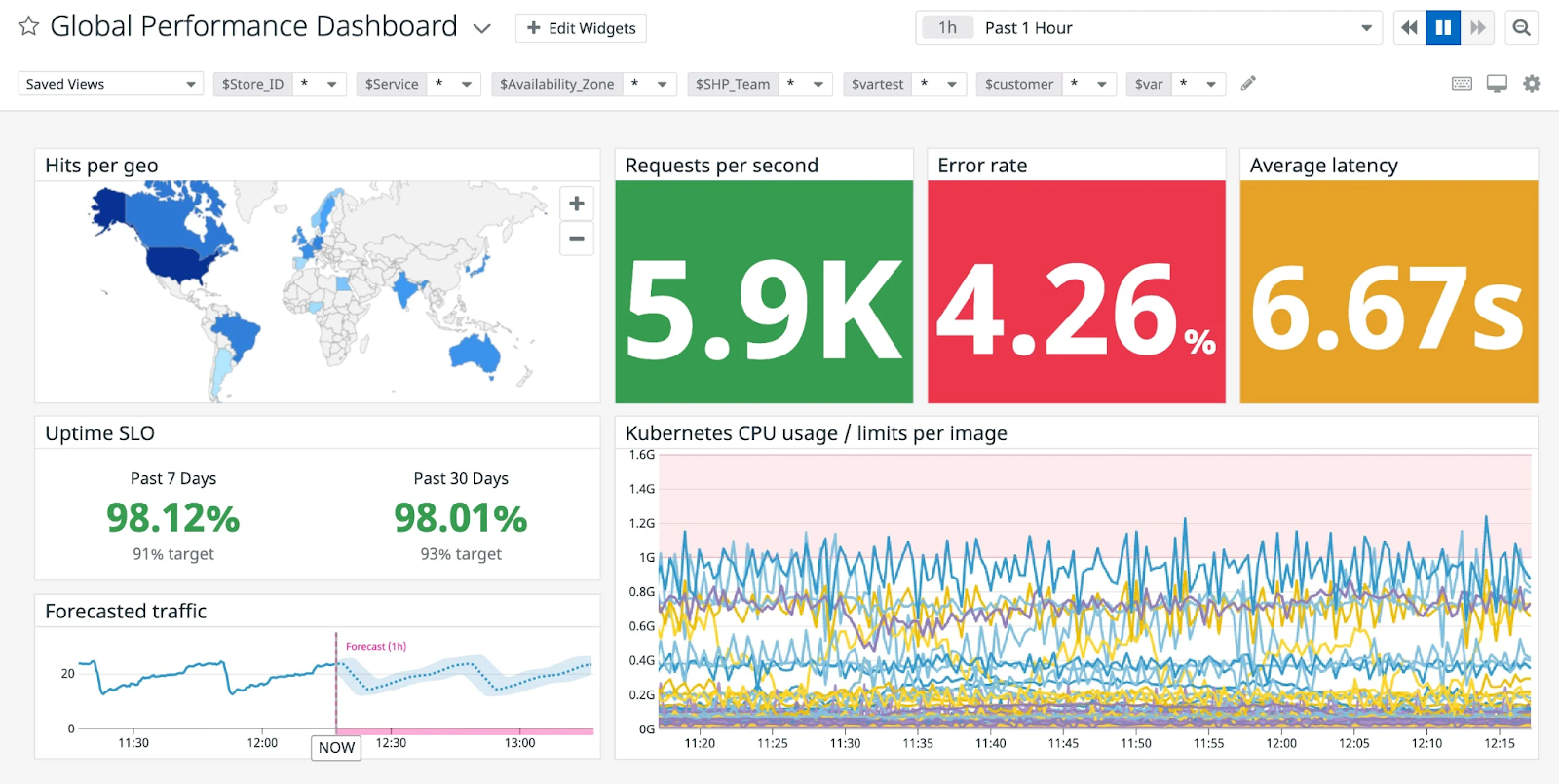
Datadog stands as a compelling alternative to traditional solutions, leading the way in modern monitoring and security. Providing unparalleled visibility across all layers of your stack and applications, regardless of scale or location, Datadog excels in delivering comprehensive insights.
With Datadog's Application Performance Monitoring (APM), fueled by AI, users can access detailed code-level distributed tracing spanning browser and mobile applications, backend services, and databases.
Key Features
- Infrastructure Monitoring: Gain real-time insights into your system's health and performance to ensure proactive management and swift issue resolution.
- Network Performance Monitoring: Optimize your network's efficiency and reliability to provide continuous visibility into the performance of your network infrastructure.
- Network Device Monitoring: Ensure the stability and health of your network devices by detecting issues promptly and maintaining a robust network infrastructure.
Pricing
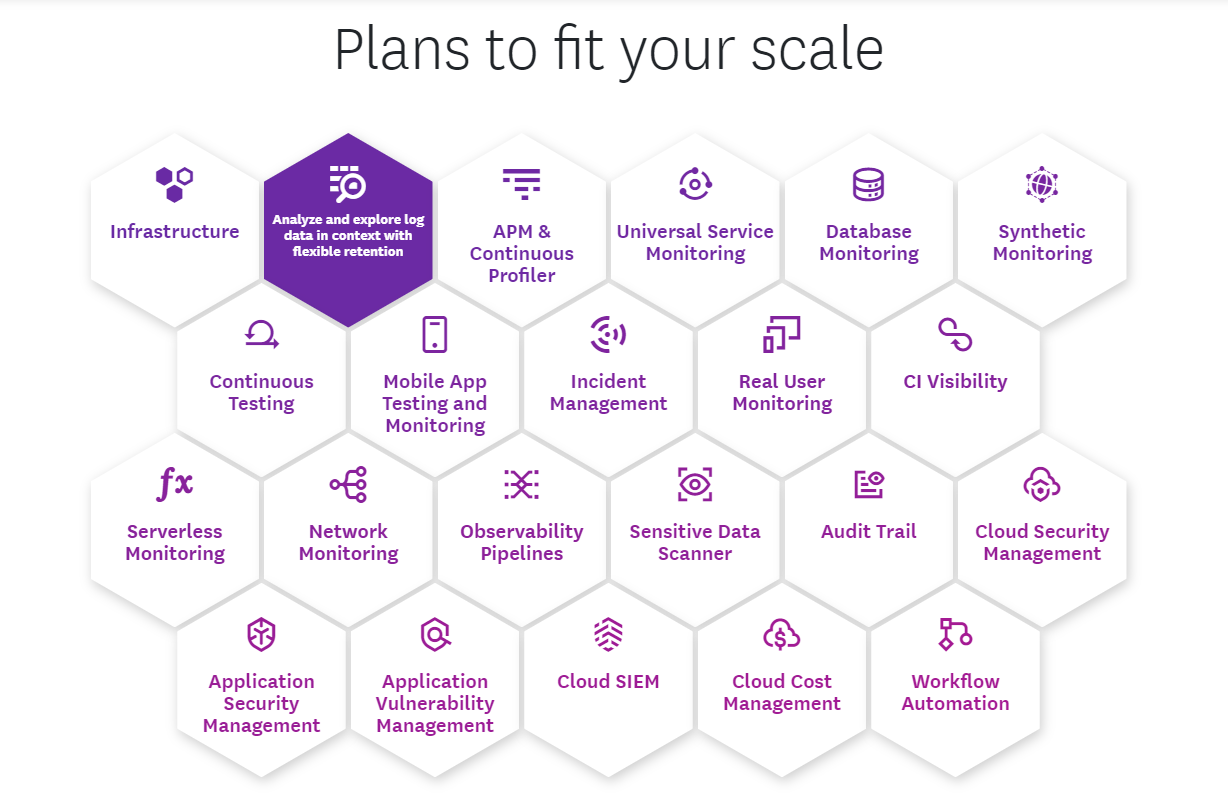
Explore various pricing options tailored to different features with Datadog. Visit their website for detailed information on available pricing plans.
2. New Relic
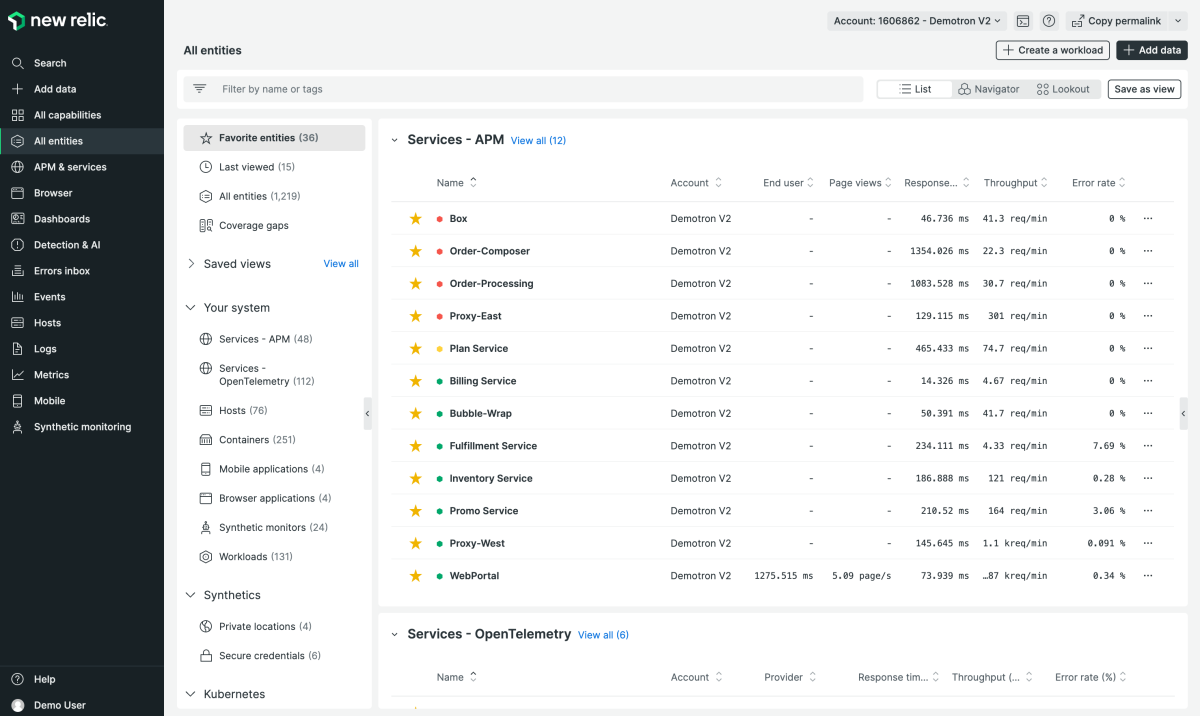
Positioned as a robust alternative to traditional solutions, New Relic serves as a comprehensive observability platform. Boasting over 30 capabilities and seamless integration with 700+ tools, it provides AI-powered insights, eradicating data, tools, and team silos.
The New Relic Platform ensures full-stack observability across your enterprise, allowing you to proactively predict and detect issues before they impact customers, establishing a proactive approach to observability and issue resolution.
Key Features
- Web Performance Monitoring: Monitor and assess the performance of web applications, emphasizing factors such as speed, responsiveness, and overall user satisfaction.
- Session Replay: Review and analyze user sessions on your platform visually, assisting in optimizing the user experience and pinpointing potential issues.
- APM 360: Anticipate and mitigate issues proactively by maintaining a unified view of telemetry throughout your development and application stack.
Pricing
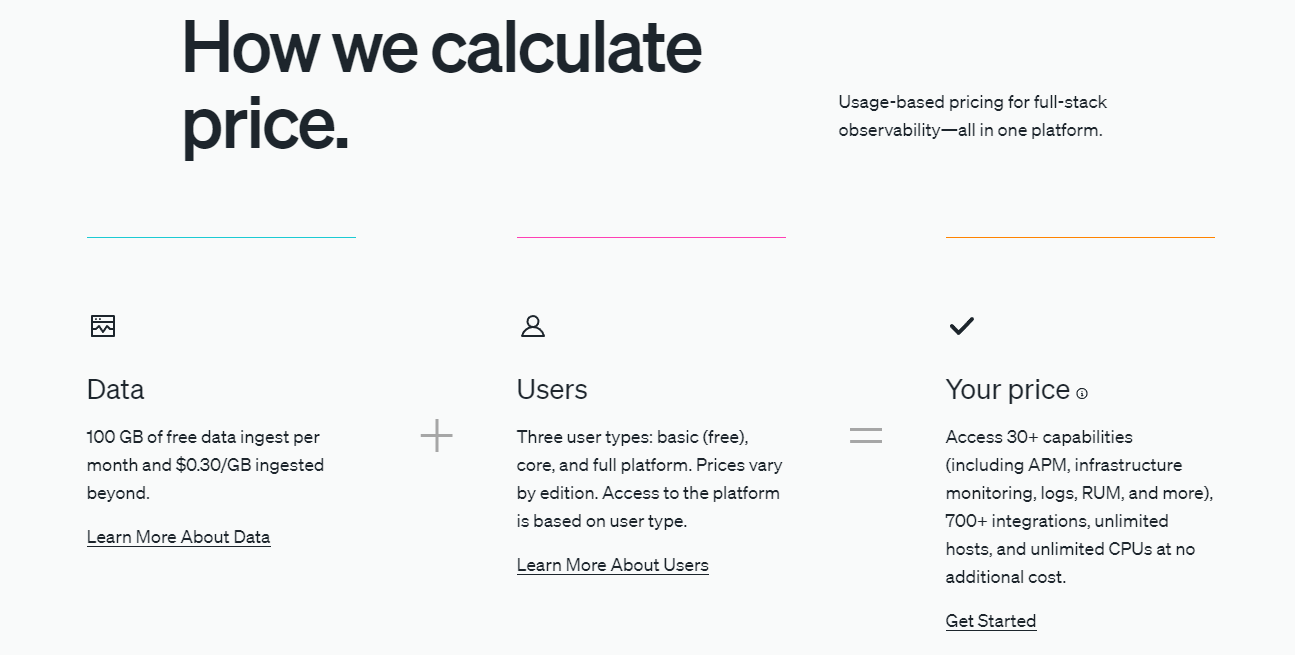
New Relic's pricing model centers on data ingestion and user types. Users enjoy 100 GB of free monthly data ingest, with a $0.30/GB charge for additional usage. Three user types—basic (free), core, and full platform—offer distinct pricing and access to 30+ features including unlimited hosts and CPUs without extra cost.
3. SolarWinds

SolarWinds presents a cost-effective alternative to Splunk with its network monitoring software. Swiftly identifying, diagnosing, and addressing network performance issues, it serves as a solid solution for comprehensive IT management.
Key Features
- Network Management: Oversee and optimize the performance of your network for seamless connectivity and identify potential issues proactively.
- Application Management: Streamline and enhance the performance of your applications by focusing on monitoring, optimizing, and ensuring the reliability of your software systems.
- Database Management: Effectively manage and maintain the health of your databases to ensure optimal performance, security, and reliability for your critical data infrastructure.
Pricing
There’s no pricing information available on their website. However, you can contact their sales team to request a quote.
SolarWinds’ pricing depends on the features you want to use. Networking monitoring costs $12 per month, billed annually. However, you can start your free trial to get a preview of what it can do.
4. Dynatrace

Dynatrace is an analytics and automation platform fueled by causal AI. Monitor and secure your entire stack on a unified, AI-powered data platform, addressing digital challenges with complete visibility and precise answers that drive efficient automation.
Key Features
- Infrastructure Observability: Achieve automated and intelligent infrastructure monitoring and observability in hybrid and cloud environments, powered by precise AI-driven insights.
- Application Observability: Optimize service performance and meet SLOs with top-notch APM.
- Application Security: Enable scalable DevSecOps with a distinctive strategy for securing cloud-native applications in real-time, complemented by intelligent automation.
Pricing


Choose from Dynatrace's affordable pricing options for monitoring:
- Full-stack monitoring ($0.08/hr)
- Infrastructure monitoring ($0.04/hr)
- Kubernetes monitoring ($0.002/hr)
- Application security ($0.018/hr)
- Real user monitoring ($0.00225/session)
- Synthetic monitoring ($0.001/synthetic request).
For log management & analytics:
- Ingest & Process ($0.20/GiB)
- Retain ($0.0007/GiB per day)
- Query ($0.0035/GiB)
5. Nagios

Nagios Core stands as a well-established open-source monitoring solution, appreciated for its enduring presence and the support of a vibrant developer community. Its strength lies in offering a flexible and extensible monitoring architecture, allowing users to customize their monitoring and alerting tools to suit a variety of needs across different industries.
Key Features
- Nagios XI: Thoroughly monitor vital components, applications, and systems using Nagios XI's proprietary add-ons and an extensive library of third-party add-ons.
- Nagios Fusion: Equip IT operations staff and management with instant, comprehensive insights across your entire IT infrastructure for swift responses.
- Nagios Network Analyzer: Utilize a fully customizable bandwidth utilization calculator to generate reports that summarize bandwidth usage per source, IP, or any desired combination for precise and insightful monitoring.
Pricing
Nagios Core is an open-source solution so it’s free to use. This is ideal for home setups, trialing the product, or students in the IT field who want to learn using XI. However, you may request a product demonstration.
Its pricing and plans increase in cost depending on the added features. Nagios XI starts at $2,495 for the standard plan and increases up to $25,990, depending on the number of Nodes required. Nagios Log Server is $4,995 for a single instance, up to $24,995 for large-scale instances.
Both the Nagios Network Analyzer and Nagios Fusion cost $2,995 to license.
6. SigNoz

SigNoz is a full-stack open-source observability and performance monitoring tool. It included log aggregation, metric collection, traces, and alerting.
This is a great alternative to Splunk for many reasons. First, it’s open source so it’s easy to get started and find your way through its features and capabilities. Second, it utilizes OpenTelemetry, which is swiftly becoming the global standard for application instrumentation.
Third, Signoz allows you to monitor critical infrastructure metrics like CPU utilization and memory usage. Lastly, you can create custom metrics dashboards based on your infrastructure needs.
Key Features
- Integrated Observability: SigNoz provides metrics, traces, and logs under an integrated UI. This way, you can easily visualize and quickly identify and resolve issues as they happen.
- Native OpenTelemetry Support: Since it has native support for OpenTelemetry, it can generate and handle telemetry data, enabling effective observability.
- Developer-Focused Technology: This platform is built with developers in mind, using the most up-to-date technologies such as React.js. and Go Typescript.
Pricing

There are only two tiers of Signoz’s pricing. The Teams plan starts at $199 per month. You’ll need to contact the company directly for pricing options about the Enterprise Cloud tier.
7. Logstash

Logstash is an open-source data collection tool with real-time features and capabilities. It provides an easy-to-build pipeline for data collection from a wide range of sources. It is easily paired with tools like Elasticsearch and Kibana to collect, parse, and transform data, which can then be sent to several destinations.
Similar to Splunk, Logstash collects data from different sources, such as system metrics, network traffic, and log files. Afterward, it processes that data using various filters, which can be used to extract, transform, and simplify the data so they become more structured. Structured data is easier to search and analyze.
Logstash is an alternative to Stash because of its free, open-source functionality and architecture.
Key Features
- Platform-Agnostic Portability: Being able to run on numerous platforms lets users run Logstash on their preferred platform.
- Seamless Tool Integration: This can be integrated with Kibana, Elasticsearch, Grafana, and Prometheus.
- Customization Flexibility: Logstash lets you create customizations and extensions that fulfill your needs on data inputs, outputs, and processing.
Pricing

Logstash is open-source and free to use. It can be purchased as part of the large suite of Elastic Stack tools. A free trial is available.
8. Graylog
Graylog is a powerful open-source log management and SIEM tool that centralizes log data for efficient monitoring, search, and analysis. It’s built for scalability and real-time insights, making it a practical alternative to costly enterprise platforms like Splunk.
With its user-friendly web interface and customizable dashboards, teams can easily visualize log patterns, detect anomalies, and pinpoint issues. Graylog supports a wide range of use cases, including infrastructure troubleshooting, application debugging, compliance auditing, and security monitoring.
Its flexible architecture allows integration with popular systems and data sources, offering reliable performance for organizations of all sizes. Ideal for developers, system administrators, and security teams, Graylog delivers powerful observability without the steep learning curve or price tag.
Key Features
- Centralized Log Management: Collect logs from across your infrastructure and view them in one place for easy analysis and correlation.
- Custom Dashboards: Build real-time dashboards with powerful visualizations to monitor KPIs and detect anomalies instantly.
- Alerting & Notifications: Set custom alerts and receive notifications via email, Slack, or other integrations when predefined conditions are met.
efforts.
Pricing
Graylog offers a free open-source edition suitable for many teams, while the Enterprise edition includes advanced features like archiving, reporting, and support. Pricing is available upon request, depending on your deployment size and feature requirements.
9. Sumo Logic
Sumo Logic is a cloud-native machine data analytics platform designed to provide real-time insights for application performance, infrastructure monitoring, and security analytics.
As a scalable and flexible alternative to Splunk, it’s widely adopted by DevOps, IT, and security teams operating in dynamic cloud environments. Sumo Logic excels in speed and simplicity, automatically scaling to meet your organization’s data and user demands. It enables efficient ingestion, search, and analysis of large data volumes without the need to manage underlying infrastructure.
With built-in security, intelligent analytics, and centralized monitoring, Sumo Logic helps teams detect, investigate, and respond to issues faster, improving system reliability and operational efficiency across the enterprise.
Key Features
- Unified Logs & Metrics: Collect and analyze logs and metrics in a single platform to gain complete visibility across your systems.
- Machine Learning-Powered Insights: Automatically detect anomalies, find root causes, and prevent future incidents using ML and pattern recognition.
- Security Analytics (SIEM): Detects and responds to threats faster with built-in security features, including threat intelligence and compliance auditing.
Pricing
Sumo Logic offers a free trial with core functionality. Paid plans vary based on data ingest volume, retention duration, and features required. They offer flexible pricing tiers for infrastructure monitoring, log management, and security analytics.
10. ELK Stack (Elasticsearch, Logstash, Kibana)
The ELK Stack is a powerful open-source solution made up of three core components: Elasticsearch, Logstash, and Kibana. It is widely used for search, log analysis, and real-time data visualization. As a popular alternative to Splunk, the ELK Stack provides a flexible, scalable, and cost-effective platform for managing and analyzing log data.
Each tool within the stack serves a specific function. Logstash collects and processes data from various sources. Elasticsearch indexes and stores that data while offering fast search and analytics capabilities. Kibana then presents the data through customizable and interactive dashboards.
Together, these tools help teams monitor infrastructure, troubleshoot applications, and gain operational insights, all without relying on proprietary software or vendor lock-in.
Key Features
- Powerful Search & Analytics: Use Elasticsearch’s lightning-fast indexing and querying to search millions of logs in seconds.
- Real-Time Dashboards: Visualize key metrics and trends with Kibana's user-friendly interface and dynamic charts.
- Highly Customizable Architecture: Adapt the stack to fit any infrastructure, from local servers to cloud-native deployments.
Pricing
The ELK Stack is open-source and free to use, with optional paid features available through Elastic’s commercial offerings. These include enhanced security, alerting, and machine learning tools. Elastic Cloud pricing is usage-based and depends on your data volume and storage needs.
11. Fluentd
Fluentd is an open-source data collector that streamlines how logs are collected, processed, and routed across modern systems. Designed to unify data collection and consumption, Fluentd allows organizations to better understand and utilize their logs.
As a lightweight and flexible alternative to Splunk, it offers a high-performance solution for managing log data without the overhead or cost of enterprise tools. It supports over 500 plugins, enabling seamless integration with a wide range of systems and outputs such as Elasticsearch, Kafka, Amazon S3, and various databases.
Thanks to its minimal resource footprint, Fluentd is particularly well-suited for cloud-native and containerized environments such as Kubernetes. It allows DevOps and SRE teams to build highly customizable logging pipelines that can adapt to complex architectures and evolving infrastructure needs.
With its combination of versatility, extensibility, and strong community support, Fluentd empowers teams to achieve end-to-end observability and centralized logging without vendor lock-in or complex setup requirements.
Key Features
- Unified Logging Layer: Collect logs from applications, servers, databases, and devices into a single structured stream.
- High Performance & Reliability: Designed for minimal resource usage and high throughput, even under heavy data loads.
- Cloud Native Friendly: Integrates easily with Kubernetes, Docker, and modern cloud infrastructure for scalable observability.
Pricing
Fluentd is completely free and open-source, licensed under Apache 2.0. It's widely adopted by companies looking for a flexible and cost-effective logging layer. Commercial support and hosted versions are available via partners like Treasure Data.
12. Humio
Humio is a modern log management and observability platform built to deliver real-time insights across large-scale systems. It stands out as a strong alternative to Splunk, especially for organizations that need instant access to logs and metrics without compromising performance or flexibility.
What makes Humio unique is its index-free architecture and in-memory data storage, allowing for incredibly fast searches across high volumes of data. This makes it a great fit for DevOps, IT operations, and security teams who rely on quick visibility to detect and resolve issues in live environments.
Designed to support complex, distributed systems, Humio excels in cloud-native and container-based infrastructures. It handles high-speed data ingestion with low latency and provides streaming data views, live dashboards, and customizable alerts that empower teams to act proactively.
Humio also offers flexible deployment options, including self-hosted and cloud-based setups, along with built-in access control features to support security and compliance. With its focus on speed, scalability, and simplicity, Humio helps organizations reduce operational overhead while gaining full observability into their systems.
Key Features
- Index-Free Architecture: Ingest and search logs at high speed without the overhead of indexing, enabling lightning-fast querying.
- Real-Time Streaming Data: Analyze and visualize data in real-time to detect anomalies and respond to incidents as they occur.
- Efficient Storage Compression: Store more data with less overhead using advanced compression and retention strategies.
Pricing
Humio offers both self-hosted and cloud-based solutions. Pricing is based on data ingestion volume and retention duration. A free trial is available, and you can contact their sales team for tailored enterprise pricing.
Why Listen To Us?
At Instatus we have empowered numerous clients, including prominent ones like Railway and Deno, to enhance their system monitoring and incident management. We offer a quick, cost-effective, and user-friendly alternative to traditional monitoring services.
Our platform is praised for its efficiency and ease of use, as evident in the satisfaction of our diverse client base, ranging from small startups to large enterprises.
Why Look For Splunk Alternatives?
While Splunk stands out as a popular and powerful choice for many, it's essential to consider other options that may align more closely with your organization's unique objectives and constraints. Here are some of the reasons why you should consider other alternatives:
- Cost: Splunk is a commercial product generally more expensive than open-source alternatives. Users on a tight budget may prefer open-source options, which can offer similar functionalities at a lower or no cost.
- Flexibility and Customization: Some alternatives are often more flexible and customizable than Splunk. They can be modified and extended to meet specific needs, and users have access to the source code, offering a significant advantage for businesses with unique requirements.
- Integration with Other Tools: Some businesses prefer using open-source tools that can be easily integrated with other open-source technologies, rather than being tied to a proprietary platform like Splunk.
- Handling of Large Data Volumes and Interface: Some customers find Splunk not the best for managing large quantities of data and criticize its licensing model and outdated interface. Users seeking more modern, user-friendly interfaces or better scalability might look for alternatives.
- Specific Needs and Workflow Compatibility: Users sometimes seek more niche-focused solutions with different pricing structures or interfaces that better suit their team's workflow. In such cases, finding a Splunk competitor becomes a quest for a solution that caters more precisely to their unique needs and circumstances.
Criteria To Look For When Choosing A Splunk Alternative
Here are some criteria to consider when choosing an alternative to Splunk:
Real-time Monitoring
Ensure the chosen platform excels in real-time monitoring, enabling immediate and continuous tracking of your digital systems' activities. This feature is critical for promptly identifying and responding to potential security threats, system anomalies, or performance issues.
With capabilities ranging from website and API monitoring to keyword, SSL, TCP, ping, and DNS checks, Instatus provides a holistic approach to system health. We conduct 30-second checks from multiple locations, enabling immediate detection of any disruptions or performance issues.
Integration
Choose a solution that excels in seamless integration, allowing effortless collaboration with existing tools and technologies within your digital ecosystem. A robust integration capability ensures that your chosen platform can smoothly connect and interact with various software applications, databases, and infrastructure components.
Instatus takes monitoring to a new level by offering seamless integrations with popular monitoring tools such as Site24x7, Pingdom, and Datadog.
Customization Options
Opt for a solution that offers flexibility and customization to tailor security measures according to your specific organizational needs.
Scalability
Prioritize a platform that demonstrates exceptional scalability, ensuring it can effectively adapt and expand alongside the evolving demands of your digital systems. Scalability goes beyond just accommodating growth, it involves the platform's capacity to handle increased data, users, and transactions without compromising performance or security.
Vendor Support and Community
When considering a platform for securing and maintaining your digital systems, it is crucial to thoroughly evaluate the support infrastructure provided by the vendor and the vibrancy of the associated community.
The level of responsiveness and expertise from the vendor's support team directly influences your ability to address issues swiftly and maintain the resilience of your systems.
Data Ingestion and Indexing Efficiency
Your Splunk alternative should efficiently manage enormous volumes of data ingestion and indexing without major performance degradation. If not, you’ll risk the speed and accuracy of your analytics.
Cost and Licensing Flexibility
Make sure you study the pricing model and licensing options of your chosen tool to ensure it aligns with your budget and usage needs, especially if your data volumes and analytics requirements will grow over time.
Best platform for generating a status page: Instatus
Effortlessly generate an aesthetically pleasing status page in just 10 seconds without the hefty price tag. Instatus not only maintains customer satisfaction during downtime but also serves as an effective tool to reduce support ticket volumes and foster customer trust.
With Instatus, time-saving is prioritized, allowing teams to concentrate on issue resolution instead of being tied up in email responses. We streamline the process of publishing updates to a matter of seconds, consolidating information in one accessible location for customers to check status easily.
Conclusion
The constant functioning of our digital assets is not just convenient but essential for building trust, satisfying users, and strengthening organizational resilience. A strong platform protects our digital infrastructure, providing real-time monitoring, quick issue resolution, and a vital layer of security.
To complement any of our listed Splunk alternatives, you can consider Instatus. Our solution not only keeps a vigilant eye on websites and applications with various checks but also seamlessly integrates with existing monitoring tools, creating a unified solution for comprehensive system oversight.
Get your status page now!
Get ready for downtime
Monitor your services
Fix incidents with your team
Share your status with customers


